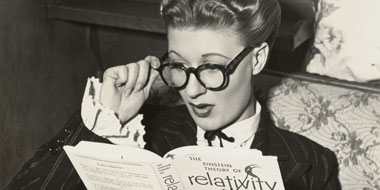Signs – Books – Networks: from Cuneiform to Binary Code
 Photo: PUNCTUM/Bertram Kober
Photo: PUNCTUM/Bertram Kober
The exhibition
“Signs – Books – Networks: from Cuneiform to Binary Code”, on permanent display at the German National Library’s German Museum of Books and Writing, provides a brief history of humanity based on the three media innovations of writing, book printing and digital networks.
Tally sticks, tattoos, anatomy textbooks, neon signs, camouflaged publications, gravestones, novels and love letters – humans have been using written characters to record their messages, fantasies and knowledge of the world for more than 5,000 years. Before writing was invented, people passed information from generation to generation by word of mouth. However, writing, book printing and computers now enable knowledge to be stored for posterity.
The exhibition invites visitors to investigate early forms of communication, memory techniques, writing systems, historic book formats and modern recording techniques. It sheds light on the advances made by Johannes Gutenberg, opens up “worlds of reading”, reports on cases of censorship and presents masterpieces of medieval and modern book art. The rapid development of media at the beginning of the 20th century illustrates how books have lost their status as the most important medium and now have to compete with radio, television and digital net worlds. At the end of the tour, the exhibition takes a tongue-in-cheek look at the future of media in six artistic dioramas.
In 2013, the permanent exhibition was awarded the Antiquaria Prize for Book Culture. The jury justified its decision as follows: “The judiciously chosen route from cuneiform to digital technology appeals to experts and non-experts alike and has met with an enthusiastic response.”
A journey in images
Information for your visit
Opening hours and admission
Tuesday to Sunday 10:00 to 18:00
Thursday 10:00 to 20:00
Public holidays 10:00 to 18:00 (except 24 to 26 December, 31 December and 1 January)
Closed on Mondays
Admission free
Guided tours
General and theme-based guided tours of our exhibitions are held on a regular basis.
To the events calendar
Group tours
You are also welchome to book group tours with us. Simply write us an e-mail:
dbsm-info@dnb.de
Accessibility
The exhibition has barrier-free access.
Address and getting here
German National Library
German Museum of Books and Writing
Deutscher Platz 1
04103 Leipzig
Getting here
We advise you to use public transport.
1 / By public transport
By rail
From the main railway station, take S-Bahn S1 in the direction of Riesa, S2 in the direction of Markkleeberg-Gaschwitz, S3 in the direction of Stötteritz or S5/S5X in the direction of Zwickau. Journey time approx. 7 minutes, get off at “Leipzig MDR”. Exit onto Semmelweisstraße, then turn right and continue for 400 m to the intersection at Straße des 18. Oktober.
Alternatively, take tram line 16 from platform 2 in front of the main railway station (in the direction of Lößnig) and get off at “Deutsche Nationalbibliothek”. Journey time approx. 11 minutes.
By air
From Leipzig/Halle airport, take S-Bahn S5/S5X in the direction of Zwickau. Journey time approx. 30 minutes, get off at “Leipzig MDR”. Exit onto Semmelweisstraße, then turn right and continue for 400 m to the intersection at Straße des 18. Oktober.
2 / By car
Approaching from the north
Take the A9 to the Schkeuditzer Kreuz intersection, continue on the A14 towards Dresden and take the Leipzig-Mitte (city centre) exit; continue on the B2 towards Leipzig city centre as far as the intersection at Prager Straße/Semmelweisstraße (follow the signs for “Deutsche Nationalbibliothek”).
Approaching from the south and east
Take the A9 or A14, change to the A38 and continue to the Leipzig-Süd exit; change to the B2 and continue to the Südvorstadt exit; turn right into Kurt-Eisner-Straße and continue to the German National Library.
3 / Accessibility
The German National Library in Leipzig has disabled parking spaces right in front of the building. The entrance for disabled visitors is signposted. The reading rooms and cafeteria are accessible by lift.
Last changes:
08.02.2023
Short-URL:
https://www.dnb.de/sbn
Contact:
dbsm-info@dnb.de





